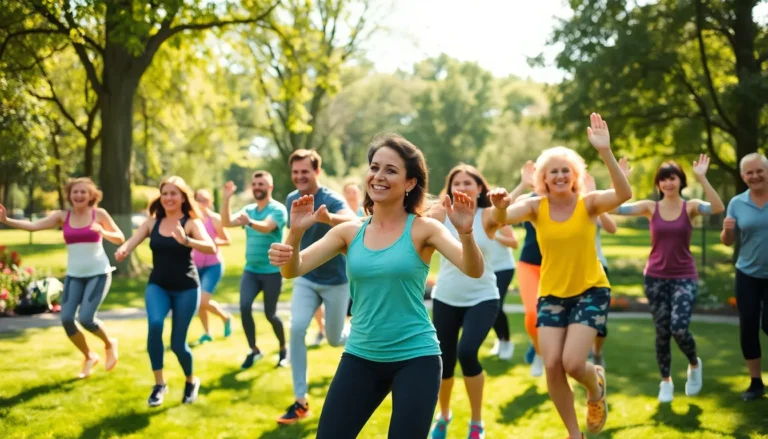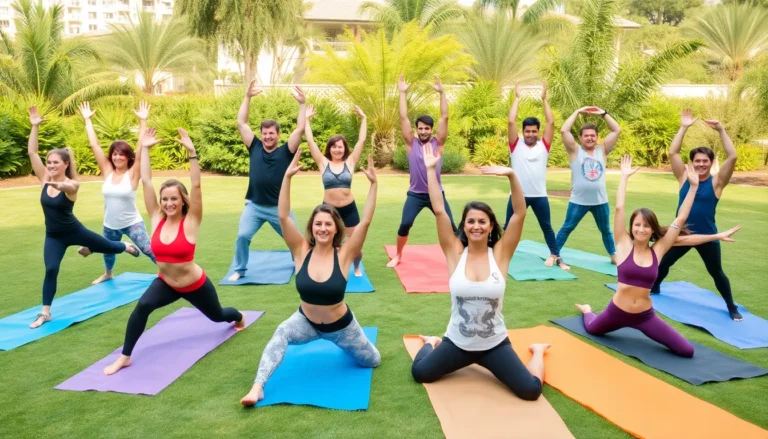Book Appointment Now
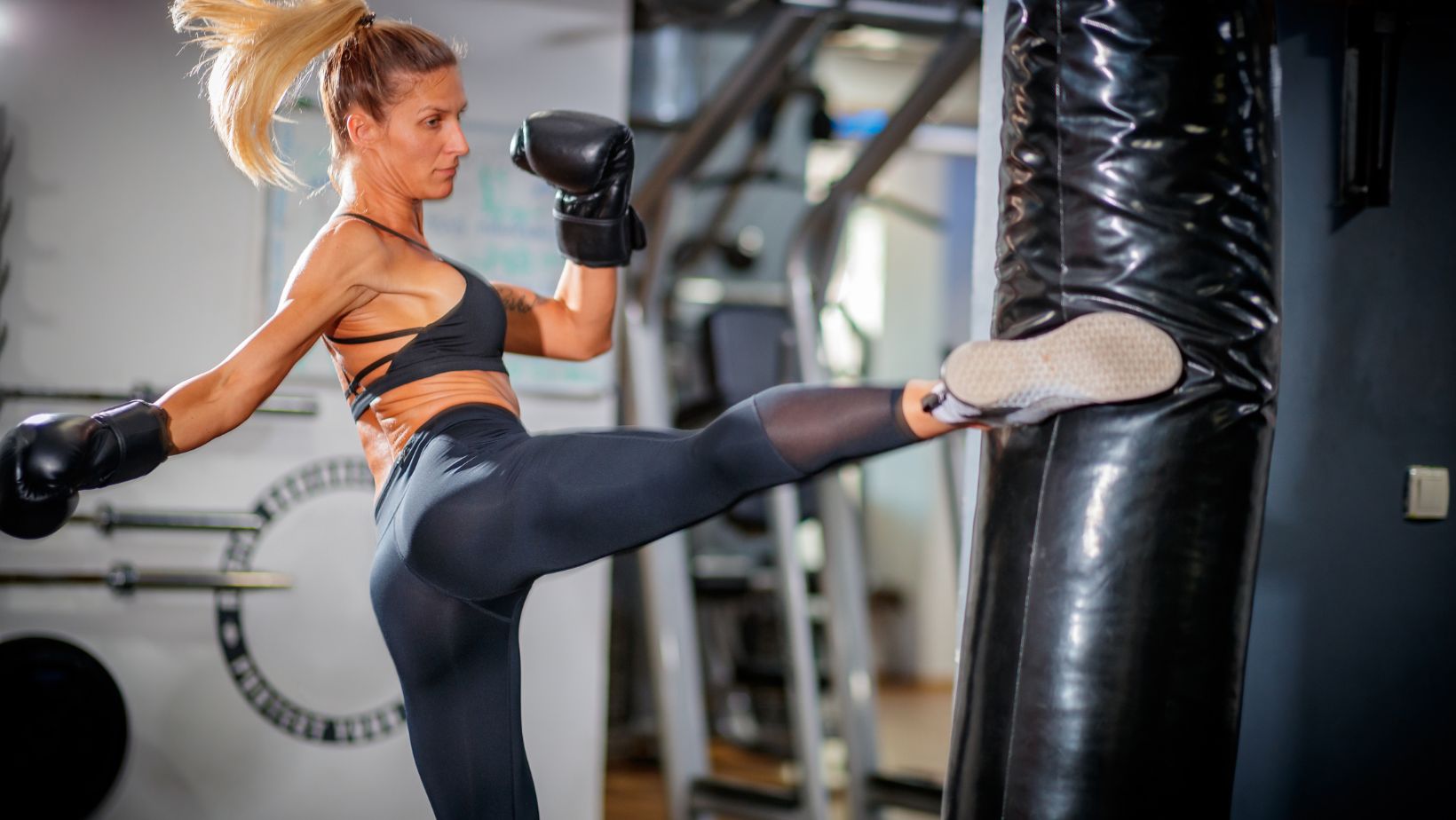
Unlock Your Potential: The Ultimate Guide to Fitness Kickboxing for All Levels
Key Takeaways
- High-Calorie Burn: Fitness kickboxing can burn between 500 to 800 calories per hour, making it an effective workout for weight loss.
- Full-Body Workout: Combines punches, kicks, and footwork to build strength, agility, and cardiovascular fitness.
- Stress Relief: Promotes the release of endorphins, effectively reducing stress and anxiety levels.
- Self-Defense Skills: Participants learn practical martial arts techniques, enhancing personal safety and self-confidence.
- Inclusivity: Offers classes for all fitness levels, ensuring everyone can improve their skills and fitness at their own pace.
- Essential Gear: Proper equipment like boxing gloves, hand wraps, and supportive shoes enhances performance and safety during workouts.
Fitness kickboxing is more than just a workout; it’s a high-energy fusion of martial arts and cardio that packs a punch. This dynamic exercise form not only torches calories but also builds strength, agility, and endurance. With its roots in traditional kickboxing, it offers a fun and engaging way to stay fit while learning self-defense techniques.
As participants throw punches and kicks, they also experience a thrilling release of endorphins, making it an effective stress buster. Whether someone’s a seasoned athlete or a beginner, fitness kickboxing caters to all levels, providing a supportive environment to improve fitness and boost confidence. Dive into the world of fitness kickboxing and discover how it can transform both body and mind.
Fitness Kickboxing
Fitness kickboxing is a high-energy workout that combines martial arts techniques with cardiovascular exercise. This dynamic routine focuses on both fitness and self-defense, making it appealing to a broad audience.
History of Fitness Kickboxing
Fitness kickboxing emerged in the 1970s as fitness instructors began incorporating martial arts techniques into traditional aerobic workouts. Bruce Lee’s popularity and the rise of martial arts in America influenced its development. By the 1980s, the format gained traction in gyms, becoming a staple for promoting both fitness and self-defense training. Over the years, various styles, including boxing, karate, and taekwondo, contributed to its evolution, leading to the diverse classes available today.
Benefits of Fitness Kickboxing
Fitness kickboxing offers numerous benefits:
- Calorie Burning: It effectively burns 500 to 800 calories per hour, depending on the intensity.
- Increased Strength: The combination of punches and kicks builds strength in major muscle groups.
- Enhanced Agility: Regular practice improves coordination and quickens reflexes.
- Cardiovascular Fitness: It boosts heart health through higher cardiovascular endurance.
- Stress Relief: The physical activity promotes the release of endorphins, reducing stress and anxiety.
- Self-Defense Skills: Participants learn practical techniques that enhance personal safety.
- Boosted Confidence: Mastering new skills and routines fosters a sense of achievement and empowerment.
Fitness kickboxing not only enhances physical fitness but also supports mental health and self-esteem, making it an all-encompassing workout option.
Getting Started with Fitness Kickboxing
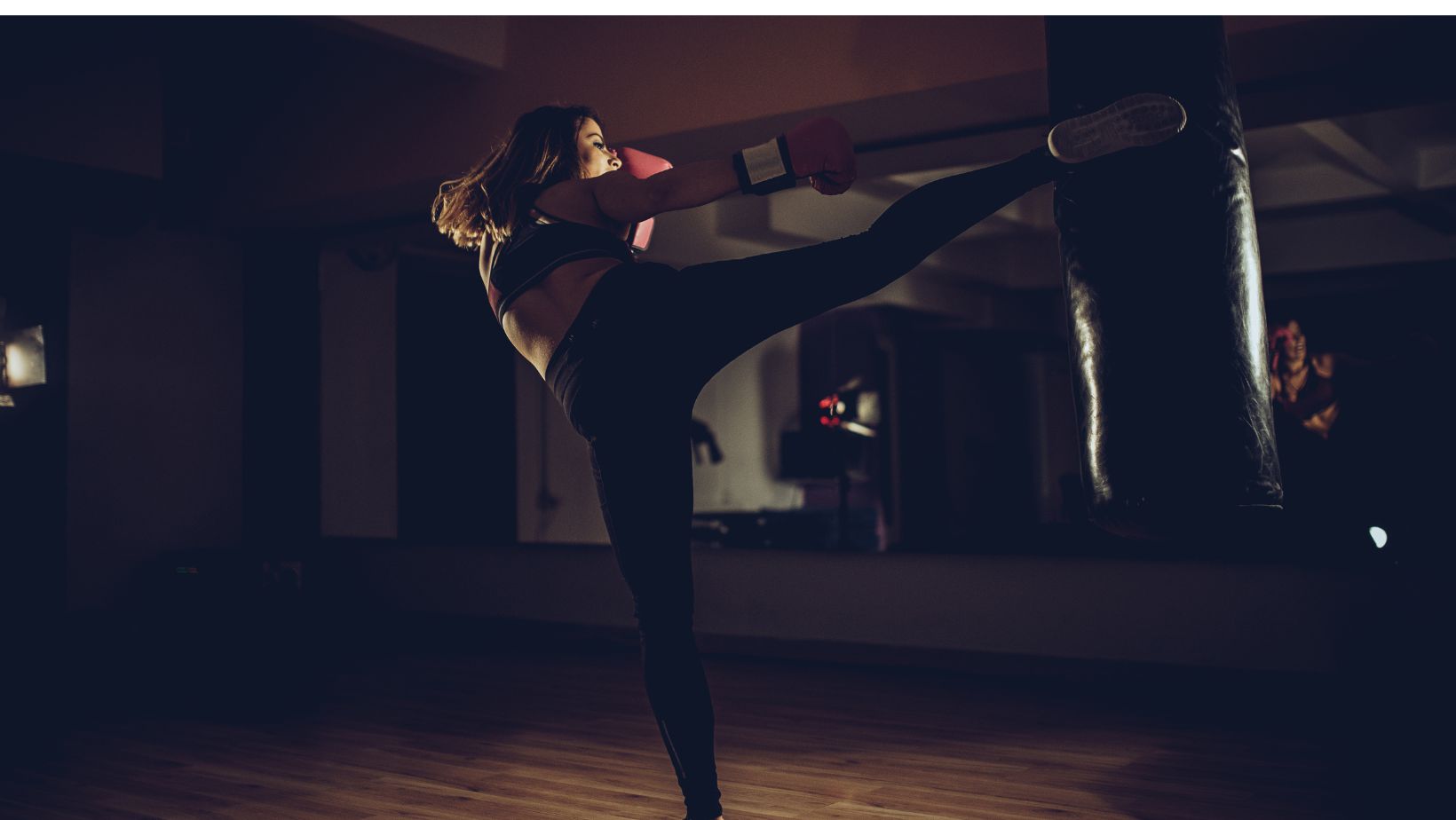 Fitness kickboxing offers a vibrant entry into a dynamic workout routine. Participants can start by selecting an appropriate class and gathering essential gear.
Fitness kickboxing offers a vibrant entry into a dynamic workout routine. Participants can start by selecting an appropriate class and gathering essential gear.
Choosing the Right Class
Choosing the right class involves assessing personal fitness levels and goals. Various types of fitness kickboxing classes exist, including beginners, intermediates, and advanced sessions. New participants should look for classes labeled as “beginner” or “introductory,” ensuring a comfortable learning pace. Checking the qualifications of instructors adds another layer of assurance, as experienced trainers often provide better guidance on techniques and safety.
Essential Gear and Equipment
Essential gear and equipment enhance the fitness kickboxing experience and safety. Participants typically require:
- Boxing Gloves: Standard 12 to 16-ounce gloves protect hands and absorb impact during workouts.
- Hand Wraps: Cotton or synthetic wraps provide wrist support and add padding beneath the gloves.
- Fitness Shoes: Sturdy, cushioned shoes prevent slips and provide adequate support for lateral movements.
- Shin Guards: Protective gear reduces the risk of injury during kicks and sparring sessions.
- Comfortable Workout Attire: Breathable, flexible clothing enhances mobility and comfort during exercises.
Investing in quality gear ensures safety and effectiveness in the fitness kickboxing journey.
Techniques and Movements in Fitness Kickboxing

Fitness kickboxing incorporates various techniques and movements that enhance physical fitness and self-defense skills. Participants engage in a series of punches, kicks, and footwork drills, building strength, agility, and coordination.
Basic Punches and Kicks
Basic punches include:
- Jab: A quick, straight punch delivered with the lead hand. It’s essential for distance control.
- Cross: A powerful straight punch thrown with the rear hand, used to follow up the jab.
- Hook: A punch that arcs horizontally, targeting the opponent’s head or body.
- Uppercut: An upward punch aimed at the chin, effective in close-range situations.
Basic kicks consist of:
- Front Kick: A straight kick aimed at the opponent’s face or body using the ball of the foot.
- Roundhouse Kick: A kick that sweeps in a circular motion, targeting the side of the opponent.
- Side Kick: A powerful, sideways kick that delivers force to the target’s body or head.
- Back Kick: A reverse kick aimed over the shoulder, useful for surprising opponents.
These punches and kicks combine to create an effective striking arsenal that enhances fitness while teaching self-defense techniques.
Footwork Fundamentals
Footwork plays a crucial role in fitness kickboxing, allowing for efficient movement and positioning. Key footwork elements include:
- Stance: A balanced position that allows for quick movement and stability. Feet should be shoulder-width apart, with knees slightly bent.
- Shifting Weight: Moving weight from one foot to the other promotes balance and prepares one for strikes or evasions.
- Step-Lateral Movement: Moving side-to-side maintains distance from opponents while facilitating defensive maneuvers.
- Pivoting: Rotating on the ball of the foot enables quick changes in direction and creates angles for strikes.
Mastering these footwork fundamentals enhances overall performance in fitness kickboxing, ensuring agility and efficiency during workouts.
Fitness Kickboxing for Different Fitness Levels
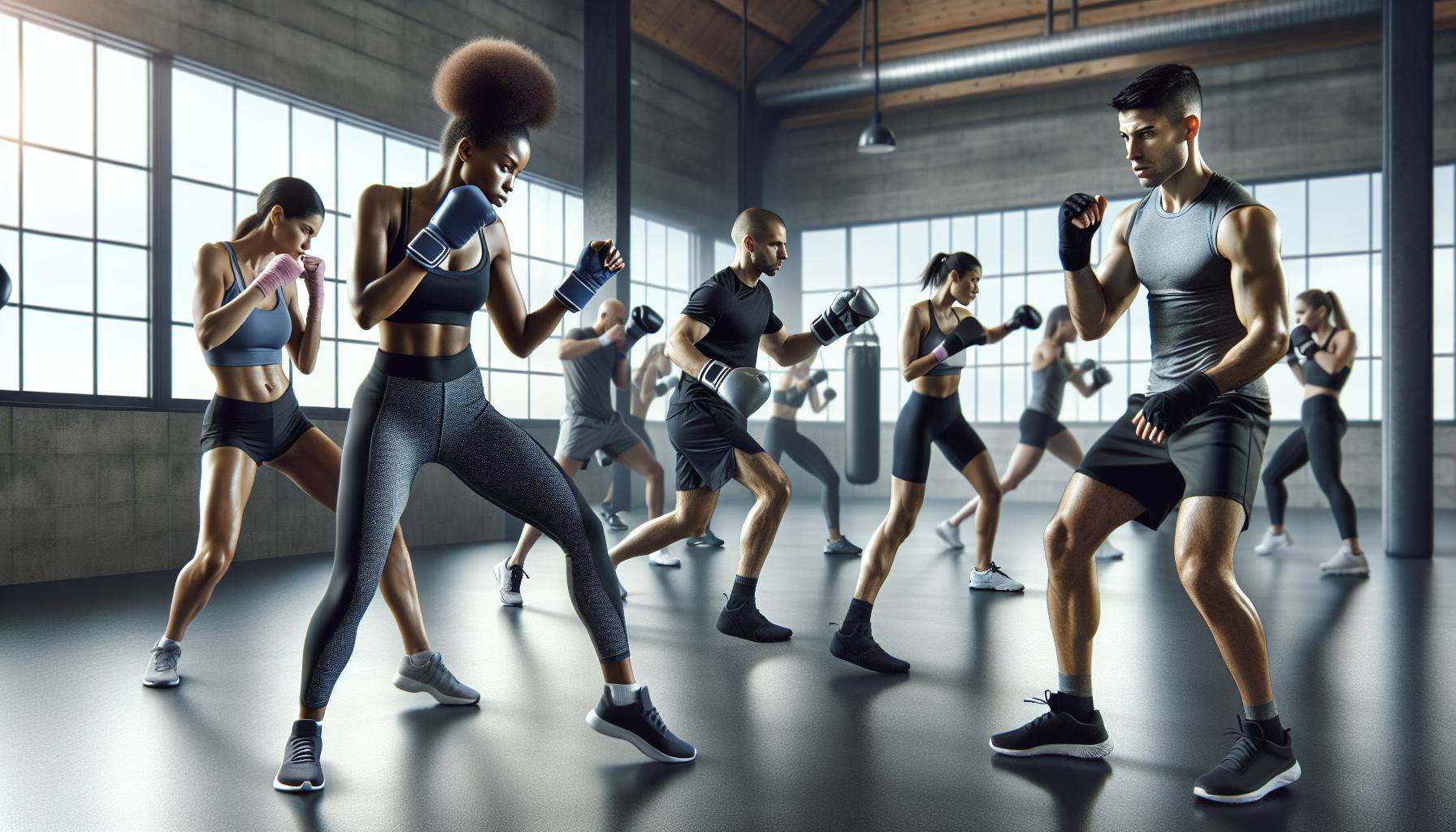
Fitness kickboxing accommodates various fitness levels, ensuring everyone can participate and derive benefits, regardless of prior experience. The structure of classes allows for incremental skill development and intensity adjustment.
Beginners
Beginners join fitness kickboxing classes to establish foundational skills and build confidence. These classes prioritize basic techniques such as:
- Footwork: Learning proper stances and movements to enhance mobility.
- Punches: Mastering the jab, cross, hook, and uppercut, focusing on form and technique.
- Kicks: Introducing front kicks and roundhouse kicks at a manageable pace.
Instructors provide guidance on pacing and intensity, ensuring newcomers can develop at their own speed. Using lighter equipment, like small gloves or no gloves, allows beginners to focus on technique without overexerting themselves. Gradual progression enables participants to build endurance and strength, preparing them for more intense workouts.
Intermediate and Advanced
Intermediate and advanced classes elevate skill sets through increased intensity and complexity. Participants refine existing techniques while integrating more advanced movements such as:
- Combination Techniques: Practicing coordinated sequences of punches and kicks to enhance fluidity and timing.
- Footwork Drills: Engaging in agility exercises that improve speed and reaction times.
- Conditioning Workouts: Incorporating high-intensity interval training (HIIT) for increased cardiovascular fitness and strength.
Advanced participants often partner with peers for sparring sessions, allowing for real-time application of techniques and improving defensive skills. The progressive nature of these classes helps athletes push their limits and achieve higher fitness goals, including weight loss, muscle building, and improved reflexes.
Fitness kickboxing cultivates an inclusive environment where each level can thrive, fostering a community focused on growth and support.
Fitness kickboxing stands out as an invigorating workout that not only delivers physical benefits but also nurtures mental well-being. Participants experience a unique blend of strength training and cardio that keeps them engaged and motivated. With its roots in martial arts and its evolution into a mainstream fitness option, it caters to individuals at every fitness level.
Whether someone is looking to relieve stress improve self-defense skills or simply get in shape fitness kickboxing offers a comprehensive solution. By choosing the right class and investing in proper gear anyone can embark on this rewarding journey toward better health and confidence. It’s more than just a workout; it’s a path to empowerment and community.


